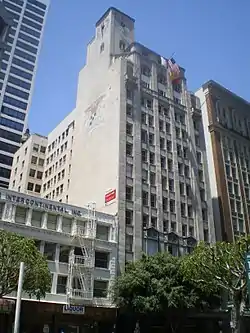James Oviatt Building
The James Oviatt Building, commonly referred to as The Oviatt Building, is an Art Deco highrise in Downtown Los Angeles located at 617 S. Olive Street, half a block south of 6th St. and Pershing Square. In 1983, the Oviatt Building was listed in the National Register of Historic Places. It is also designated as a Los Angeles Historic-Cultural Monument.
James Oviatt Building | |
 James Oviatt Building, 2008 | |
   | |
| Location | 617 S. Olive St., Los Angeles |
|---|---|
| Coordinates | 34°2′51″N 118°15′14″W |
| Built | 1927–1928 |
| Architect | Walker & Eisen; Feil & Paradise |
| Architectural style | Art Deco; Italian Romanesque |
| NRHP reference No. | 83004529 [1] |
| LAHCM No. | 195 |
| Added to NRHP | August 11, 1983 |
History

The building is named after James Zera Oviatt (born in Farmington, Utah in 1888) who, in 1909, came from Salt Lake City to Los Angeles to work as a window dresser at C.C. Desmond's Department Store. In 1912, Oviatt and a colleague, hat salesman Frank Baird Alexander, launched their partnership in men's clothing as the Alexander & Oviatt haberdashery, at 209 West Fourth Street in downtown Los Angeles.[2] Their 'silent partner' was Frank Shaver Allen, a wealthy and once socially prominent architect whose career had been destroyed by a sex scandal several years earlier.
During annual summer buying trips to Europe, Oviatt found stylish clothing to bring back to his prospering Los Angeles store. With the emergence of French Art Deco in the 1920s, Oviatt found the architectural style that would embody the interior design of his 1928 James Oviatt Building and its penthouse.[3]
The Oviatt Building was designed by the Los Angeles architectural firm of Walker & Eisen. Excavation for the Oviatt Building's construction was begun in August 1927; the building was completed in May 1928. Its furnishings included a 12-ton illuminated glass cornice and glass arcade ceiling by architect Ferdinand Chanut and glassmaker Gaëtan Jeannin. René Lalique designed and created the molded glass elevator door panels, front and side doors, chandeliers, and a large panel clock. Many tons of 'Napoleon' marble and a massive, three-faced tower clock with chimes (manufactured by the pioneering electric clockmaker, Ateliers Brillié Frères ) were imported from France.
In popular culture
A feature-length documentary on the Oviatt Building's history was directed by Seth Shulman and written/produced by Marc Chevalier in 2008.[4]
In 2015, the exterior of the Cicada was used as the exterior for the fictional Hotel Cortez on American Horror Story: Hotel.[5][6][7]
The Cicada featured in various film such as Bruce Almighty.[8]
See also
- List of Registered Historic Places in Los Angeles
- List of Los Angeles Historic-Cultural Monuments in Downtown Los Angeles
References
- "National Register Information System". National Register of Historic Places. National Park Service. April 15, 2008.
- OLIVE GRAY (August 12, 1931). "ALEXANDER AND OVIATT GOAL WON :Twentieth Anniversary of Store Marks Realization of Cherished Dreams". Los Angeles Times. p. A7. ProQuest 384752111..
- http://www.saint-anthonys.org/archive/oviatt_building_history.pdf%5B%5D
- "The Oviatt Building".
- "Scene It Before: Hotel Cortez from American Horror Story: Hotel Los Angeles Magazine". 29 October 2015.
- http://www.vulture.com/2015/10/american-horror-story-hotel-cortez-design.html
- http://www.blumhouse.com/2015/10/12/five-amazing-things-about-american-horror-story-hotel-episode-1/
- https://www.movie-locations.com/movies/b/Bruce-Almighty.php
External links
| Wikimedia Commons has media related to James Oviatt Building. |